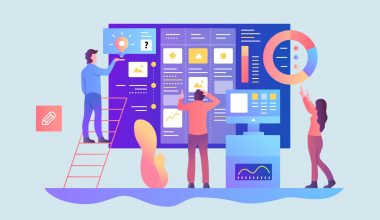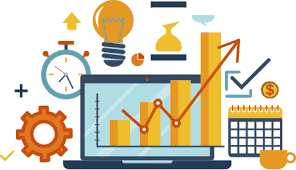If you’ve heard of design thinking, you’re probably aware that it’s an idea focused on addressing complicated problems in a creative, user-centric manner. But what is the design thinking process like, and what are the steps involved? Read on.
What is The Design Thinking Process?
Design Thinking is a process for dealing with extremely complicated problems. Complex problems, sometimes known as “wicked” problems, are difficult to characterize and cannot be solved using conventional methods and approaches. They are the polar opposite of “tame” problems that can be solved using a tried-and-true procedure or logic.
Whether it’s creating an entire business model, retaining your startup culture as the company expands, figuring out how to delight a new customer group, or settling disagreements within departments, none of these scenarios have a straightforward, tried-and-true solution. They are complex, nasty challenges that necessitate design thinking.
Design Thinking encourages thinking beyond the box, with a strong emphasis on creativity, innovation, and user demands. The Design Thinking process applies the Design Thinking theory to real-world, difficult challenges. It provides a problem-solving approach centered on solutions.
Unlike problem-based thinking, which focuses on hurdles and restrictions, the Design Thinking method is entirely focused on outcomes. It gives a non-linear sequence of steps to help you generate new, actionable ideas.
The Design Thinking Workshop
A Design Thinking workshop is one approach to putting the Design Thinking process into action.
If you have a specific challenge in mind, a specialized workshop will walk you through each step of the Design Thinking process. This ranges from developing empathy and defining the problem to prototyping and testing ideas, usually over the course of a few days or a week.
As a designer, you may invite colleagues from other departments to tap into a diverse pool of ideas. Design Thinking workshops, however, aren’t only for designers; any team may apply and benefit from this innovative approach to problem-solving.
Design Thinking, in addition to particular workshops, may be an embedded process—an overarching framework that drives how you make decisions and create specific solutions.
Instead of going through the complete Design Thinking cycle in one session, you could choose to concentrate on just one aspect. This can be getting to know your target audience (whether external customers or internal stakeholders) or conducting user tests.
In this way, the Design Thinking process may be used to foster a general culture that prioritizes putting the user first, collaborating to develop, and testing early and frequently.
What is the Purpose of The Design Thinking Process?
The purpose of the Design Thinking process is to tackle complicated problems from a human perspective. The Design Thinking process encourages creativity, innovation, and user-centeredness, allowing you to develop actionable solutions that are:
- Desired by the user
- Commercially feasible
- It is technically doable.
The Design Thinking process prioritizes the user’s wants and requirements. The first stage of the process is all about developing empathy with your target users and learning about their requirements, expectations, and habits.
Following that, you’ll concentrate on fast-building concepts into prototypes that can be tested on real consumers. Early and regular testing of your solutions is inherent in the Design Thinking process. This allows you to gather feedback and make any necessary modifications even before the product is produced.
Design Thinking allows you to identify new solutions to complicated challenges that are motivated by the needs of the target user.
What are the Steps/Stages of The Design Thinking Process?
Empathize, Define, Ideate, Prototype, and Test are the five major steps/stages in the Design Thinking process.
When studying the five steps of Design Thinking, keep in mind that it is not a linear process. Despite the fact that we describe the process in terms of sequential phases, it is a highly iterative cycle. You’ll make fresh discoveries with each phase, which may need revisiting prior phases.
With that in mind, let’s take a closer look at the five essential steps of the Design Thinking process.
#1. Empathize—Research the Needs of Your Users
User-centric research is the emphasis of the first stage of the design thinking process. You want to get an empathic grasp of the issue you’re attempting to fix. Consult with specialists to learn more about the issue, and perform observations to engage and empathize with your users. You may also want to immerse yourself in the actual world of your users to obtain a more personal grasp of the challenges at hand—as well as their experiences and motivations. Empathy is essential to issue-solving and the human-centered design process. This is because it allows designers to lay aside their own worldview assumptions and acquire actual insight into users and their requirements.
Depending on your time limits, you will collect a significant amount of information to use in the next stage. The Empathize stage’s major goal is to establish the best understanding possible of your users, their wants, and the difficulties that underpin the development of the product or service you wish to create.
#2. Define—Explain Your Users’ Needs and Issues
You will organize the information acquired during the Empathize step in the Define stage. You’ll use your observations to define the primary issues that you and your team have uncovered so far. The problem definition and problem statement must be human-centered.
You should not, for example, characterize the problem as your company’s goal or need. E.g, “We need to increase our food-product market share among young teenage girls by 5%.”
The problem statement should emphasize your understanding of the users’ needs. E.g, “Teenage girls need to eat nutritious food in order to thrive, be healthy, and grow.”
The Define stage will assist the design team in gathering fantastic ideas for features, functionalities, and other aspects that will address the problem at hand—or, at the very least, allow real users to resolve difficulties themselves with minimal hassle. You will begin to advance to the third stage, the ideation phase. At this point, you will ask questions to assist you to find solutions. E.g, “How might we encourage teenage girls to perform an action that benefits them and also involves your company’s food-related product or service?”
#3. Ideate- Create Ideas and Challenge Assumptions
Designers are ready to develop ideas during the third stage of the design thinking process. In the Empathize stage, you grew to understand your consumers and their demands, and in the Define stage, you analyzed your observations to build a user-centric problem statement. With this firm foundation, you and your team members may begin to look at the problem from many angles and brainstorm unique solutions to your problem statement.
You can employ hundreds of different ideation approaches, such as Brainstorm, Brainwrite, Worst Possible Idea, and SCAMPER. Brainstorming and Worst Possible Idea approaches are commonly employed at the beginning of the ideation stage to inspire free thinking and broaden the problem space. This helps you to develop as many ideas as possible at the beginning of the brainstorming process. You can use other ideation techniques near the end of this stage to assist you in investigating and testing your ideas and selecting the finest ones to move forward with—either because they appear to solve the problem or supply the pieces required to circumvent it.
#4. Prototype—Begin Creating Solutions
To study the major solutions created during the ideation phase, the design team will now create a number of low-cost, scaled-down replicas of the product (or specific aspects discovered inside the product). These prototypes can be shared and tested within the team, across departments, or on a small group of people outside of the design team.
This is an experimental phase in which the goal is to find the best feasible solution to each of the challenges highlighted in the previous three stages. The solutions are built within prototypes and are inspected one by one before being accepted, enhanced, or rejected based on user feedback.
The design team will have a better understanding of the product’s limitations and difficulties by the end of the Prototype stage. They will also have a better understanding of how real users would behave, think, and feel when interacting with the final product.
#5. Test Your Solutions
Designers or evaluators extensively test the entire product utilizing the finest solutions discovered during the Prototype stage. This is the fifth and last stage of the five-stage model; however, in an iterative process like design thinking, the outcomes are frequently utilized to redefine one or more additional challenges. This improved degree of understanding may assist you in investigating the conditions of usage and how people think, behave, and feel about the product, and may even take you to a previous stage in the design thinking process. You can then proceed with additional cycles, making changes and improvements to rule out alternate solutions. The ultimate goal is to gain as much knowledge about the product and its users as possible.
What are the Benefits of the Design Thinking Process?
Here are a few of the advantages of the Design Thinking process:
- The Design Thinking process teaches people how to innovate and problem-solving: While most of us are built to solve problems as they arise, we are not always driven to seek out challenges.
- Design Thinking promotes creative problem-solving by challenging you to rethink the problem area and seek out the challenge worth addressing. This is especially effective in business contexts, such as building a competitive digital product, streamlining internal procedures, or completely rethinking a business model.
- The Design Thinking process brings multidisciplinary teams together, breaks down silos, and encourages people to collaborate and challenge their assumptions.
- Design Thinking provides a proven business advantage: design-led organizations consistently outperform their competition. The goal of the Design Thinking process, as previously stated, is to provide solutions, products, or services that are desired by the user, economically viable from a company standpoint, and technologically practical. This user-first strategy, along with early and frequent testing, reduces risk, increases consumer engagement, and eventually improves the bottom line.
So, Design Thinking is a technique for problem-solving, creativity, and innovation. It not only helps designers create ground-breaking products, but it also develops an innovative and user-centric culture at all levels of the organization.
The Role of The Design Thinking Process In Entrepreneurship
Over the last decade, the global K-12 and higher education landscape has seen an increase in entrepreneurial education and training programs. Entrepreneurship is increasingly being recognized as a vehicle for developing 21st-century skills such as creativity, teamwork, self-efficacy, and critical thinking, in addition to being a source of job creation and economic progress. Simultaneously, there has been a surge in interest in human-centered design methodologies, tools, and processes, as well as their applicability in the workplace and educational contexts.
Setting ill-defined wicked problems, incorporating a formalized design thinking process model, allowing divergent and convergent thinking, building on iterations, establishing multidisciplinary teams, encouraging creative confidence, relying on informed intuition, and fostering a studio learning environment are among the nine concepts identified by researchers as having direct application to entrepreneurship education. So, how might the design thinking process be used to create an entrepreneurship mindset in your school, company, or community? Here are four ways to accomplish this:
#1. Create Wicked Problems
Wicked problems are problems that are complex, difficult to define, interconnected, one-of-a-kind, and have uncertain effects. Poverty eradication, sustainability, healthcare, and education are examples; in the corporate context, this could involve consumer research, long-term strategy planning, and business model generation. Wicked challenges are frequently expressed as “how might we” queries in the design thinking technique to stimulate unique ideas at the start of an ideation session. Set biennial or quarterly wicked challenges within your organization to encourage stakeholders from various disciplines to join in and contribute to future planning.
#2. Include A Process Model
A design thinking process model can help entrepreneurs track progress, assess outcomes, and evaluate feedback. While there are other tools available, Stanford d.school’s five-step process of empathize, define, ideate, prototype, and test is a good place to start. A process model can also aid in the development of a bigger framework and schedule for entrepreneurial endeavors inside your business or community.
#3. Encourage Divergent and Convergent Thinking
Design thinking employs a two-pronged approach that accommodates both divergent and convergent thinking approaches. Divergent thinking is often connected with creativity, originality, curiosity, and the exploration of various options, whereas convergent thinking is concerned with putting ideas together to generate single, solid solutions. The crucial issue is to separate different thinking types into distinct phases in order to avoid overly critical inputs at the exploratory stage, which could stifle the creative process, or, conversely, too many open-ended alternatives without an active answer. Tools for divergent thinking include empathy mapping and customer journey mapping, whereas tools for convergent thinking include concept selection, action planning, and prototyping.
#4. Build A Studio Learning Environment
The human-centered design framework emphasizes experimentation, cooperation, and active learning. Making, creating, and team-based interactions require physical and psychological venues that promote these mindsets. In fact, this may take the form of anything from an online collaboration tool to a formal maker-space equipped with design and technological tools. These environments’ activities should ideally be flexible, iterative, and project-based, with a focus on prototyping and testing multiple solutions.
What Are The Characteristics Of Design Thinking?
Empathy, cooperation, questioning, creativity, discovery, experimentation, and ongoing development are all fundamental aspects of design thinking.
Who Is The Mother Of Design Thinking?
Visualization is referred to as “the mother of all design tools” by most design thinkers because it is employed at every stage of the design thinking process. Visualization is a combination of listening, thinking, and drawing.
In Conclusion
Design thinking is a non-linear, iterative process that focuses on cooperation between designers and users. It brings to life creative ideas based on what real users think, feel, and do. Empathize, Define, Ideate, Prototype, and Test are the five fundamental steps of this human-centered design approach.
- PRODUCT DEVELOPMENT PROCESS: Definition, Steps & All to Know
- 15 Best Businesses to Invest in 2023
- EMPLOYEE ENGAGEMENT ACTIVITIES: Best engagement activities for work in 2023
- PRODUCT DEVELOPMENT LIFECYCLE: Definition, Process & Stages






